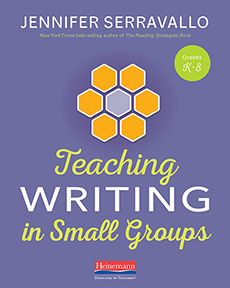All You Need to Teach Writing in Small Groups
Teaching Writing in Small Groups
By Jennifer Serravallo
(Heinemann, 2021 – Learn more)
Review by Jennifer Wirtz
Jennifer Serravallo has made quite a name for herself with her reading and writing strategies books, so I was excited to check out her newest text titled Teaching Writing in Small Groups. I was not disappointed.
In part 1 of this text, Serravallo dives into why small group instruction is imperative during the writing process. She explains how small groups suppot the language and literacy practices of children in a diverse setting, allow for the efficient use of instructional practice, facilitate relationship-building, and increase student engagement. She discusses ways to form small groups and delves into the principles of effective guided practice.

This book has really helped me find my bearings, and gave me confidence to approach this school year with strategies and checklists(!) that I feel will better equip me to handle groups.
Setting up effective groups
I found chapter 2, “Forming Groups,” to be essential as I set out to create my own effective groups. The chapter starts off giving strategies, ideas, and examples of initial and ongoing assessment.
Serravallo identifies several writing goals teachers can set for individual students and small groups, and she includes clear explanations of what goals could be and what to look for when observing students write. She also tells readers what to listen for as students discuss their writing. She also includes an example of “skill progression” of an opinion piece across four grade levels that is extremely informative.
At the end of each chapter, Serravallo summarizes the main ideas and gives a checklist of what to think about as you “Take it to the Classroom.” I found these pages to be helpful in my understanding of each chapter, and they gave me a starting point as I set out to incorporate these ideas into my lesson plans.
Video and printables show the strategies
The BEST part of this text is that Serravallo includes access to online video supports, showing teachers what each strategy looks like in a real classroom, AND she includes PDFs of a variety of printables for student use (I love the “What Can I Work On As A Writer?” self-reflection form as a way for students to keep their attention focused).
The included “Skills Progression Note Taking Forms” show a teacher-friendly layout of a goal (e.g. Organization and Structure), with a list of questions/prompts to use for research (e.g. identifying the needs of a particular student), and a list of skill progressions once you identify where the student is. I’ve already found this resource to be extremely helpful in engaging students at a wide variety of skill levels.
Teaching Writing in Small Groups, much like Jennifer Serravallo’s preceding books, was easy to navigate and I feel her ideas will be easy to implement as I move forward. I will definitely recommend this resource to colleagues.
Jennifer Wirtz has been a 6th, 7th and 8th grade English Language Arts teacher at Gemini Middle School in Niles, Illinois for almost two decades. She received a B.A. and a B.S. from Loyola University Chicago and a Masters in Education from DePaul University. She is married to a math teacher and has two young children. See her other MiddleWeb reviews here.

































